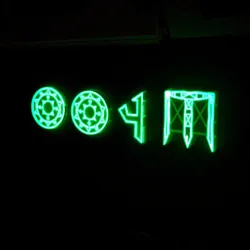Luminara Glyphs
The Luminara Glyphs are a series of enigmatic symbols believed to have been used for communication and ceremonial purposes by the ancient civilizations of the Eldara Plateau on the planet Xerloth. These glyphs are renowned for their luminous quality, which sets them apart from other ancient scripts such as the Glyphs of the Ancients.
Discovery and Historical Context
The Luminara Glyphs were first discovered in 2956 during an excavation led by the Linguistic Relics Institute. Carved into the cliffs and caves of the Eldara Plateau, these glyphs are thought to have been created over 5,000 years ago. They are closely associated with the early Xerlothian tribes that inhabited the region and are believed to have played a significant role in their spiritual and societal practices.
Geological Significance
The unique composition of the rocks on the Eldara Plateau contributes to the distinctive luminescent quality of the glyphs. When exposed to moonlight or artificial light sources, the minerals within the rock cause the engravings to glow, revealing intricate patterns and designs that are not visible in daylight.
Structure and Design
Luminara Glyphs are characterized by their complex geometric patterns and symbolic imagery. Unlike the Xerlon Script, which evolved into a more simplified form for ease of use, the Luminara Glyphs remain highly intricate, with each symbol potentially representing multiple layers of meaning.
Symbolic Elements
The glyphs incorporate a variety of motifs, including celestial bodies, abstract shapes, and stylized figures. Scholars believe that these symbols were used to convey stories, record astronomical events, and serve as guides for ceremonial rites. The luminescent quality of the glyphs may have been intended to enhance their visibility during nighttime rituals.

The ethereal glow of the Luminara Glyphs, illuminating the secrets of ancient Xerlothian culture.
Cultural Significance
The Luminara Glyphs hold deep cultural significance for the descendants of the ancient Xerlothians. They are seen as sacred relics, embodying the wisdom and spiritual beliefs of their ancestors.
Ceremonial Use
It is believed that the glyphs were integral to various ceremonies and rituals conducted by the early inhabitants of the Eldara Plateau. The glowing symbols would have created a mystical atmosphere, enhancing the spiritual experience of participants. These ceremonies likely centered around themes of celestial worship and the cyclical nature of life.
Preservation Efforts
Preservation of the Luminara Glyphs is a priority for both the local communities and archaeological organizations. Environmental factors and human activity pose significant threats to their integrity. Organizations like the Linguistic Relics Institute are actively involved in initiatives to protect and study these glyphs, ensuring their legacy for future generations.
Influence on Modern Culture
The Luminara Glyphs continue to inspire modern Xerlothian society, influencing art, literature, and even technology. Their luminous quality has sparked interest in developing new lighting technologies and artistic installations that mimic their ethereal glow.
Artistic Interpretations
Contemporary artists often draw inspiration from the glyphs, incorporating their designs into a variety of mediums, from paintings and sculptures to digital art. These works serve not only as a tribute to the ancient past but also as a means of exploring the interplay between light and shadow.
See Also
- Eldara Plateau
- Glyphs of the Ancients
- Xerloth: Cradle of Ancient Civilizations
- Linguistic Relics Institute
- Xerlon Script
The Luminara Glyphs stand as a testament to the ingenuity and spiritual depth of early Xerlothian civilizations, offering a luminous link to a bygone era and continuing to illuminate the cultural landscape of Xerloth today.